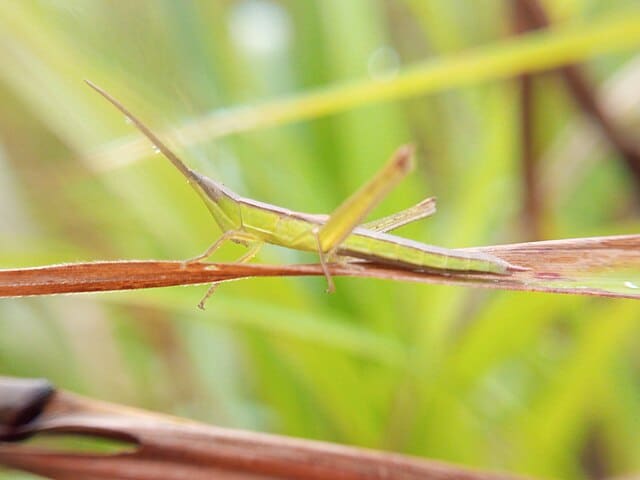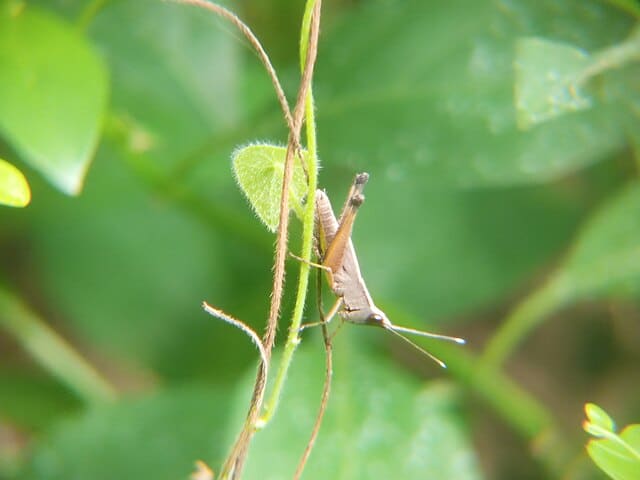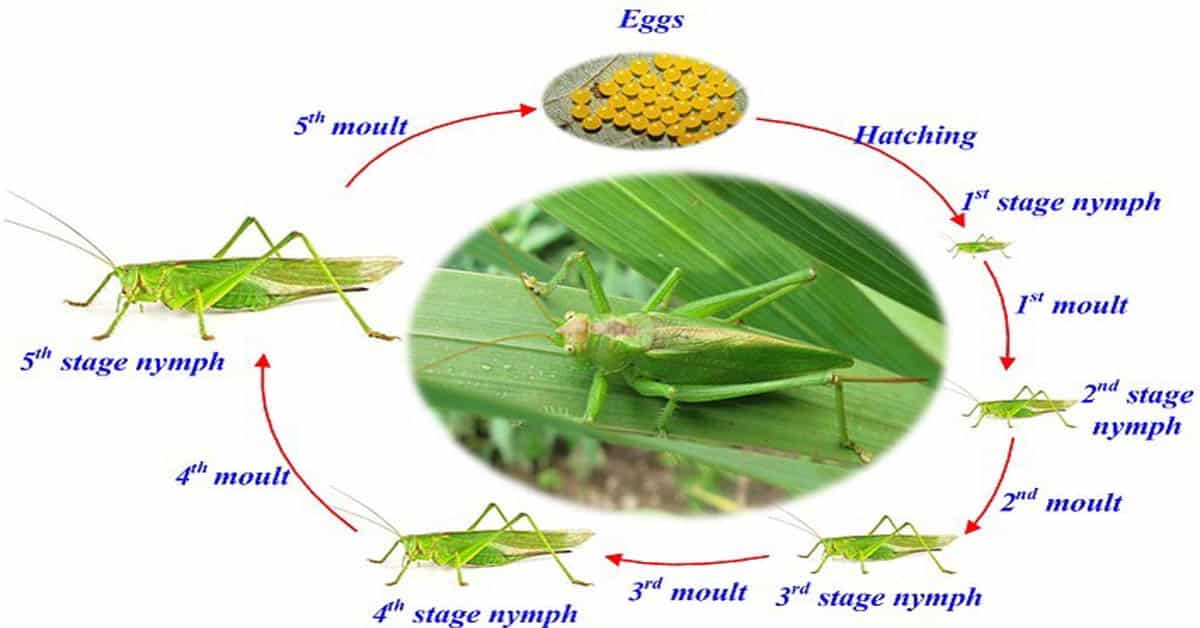Grasshopper Life Cycle – 3 Stages & Unique Characteristics
What do you know about the grasshopper life cycle? A grasshopper is a leaping insect resembling a cricket that inhabits various habitats. Grasshoppers are most prevalent in places like lowland tropical forests, semi-arid areas, and grasslands. They can have yellow or red patterns and range in color from green to olive or brown.
Grasshoppers have their own, distinct life cycle and go through a few different phases from egg to adulthood, much like every other living species on the planet. The grasshopper life cycle and characteristics will be covered in this article.

General Information about Grasshoppers
Information about these creatures can be both unusual and fascinating. Grasshoppers are roughly an inch long, can jump 20 inches, and can fly. Since grasshoppers are cold-blooded animals, they must first warm up before engaging in regular activities.
It’s interesting to note that there are between 11,000 and 20,000 species of grasshoppers in the world. The head, thorax, and abdomen are the basic structural components of this hopping organism. Pinchers, another tiny component, are employed to rip off food, including grasses, leaves, and cereal grains.
Characteristics of a Grasshopper
Grasshoppers are interesting creatures with various unique characteristics. They are part of our nature, but sometimes they may also cause some big damage. Whether you’re interested in the species or just want to control its spreading patterns. Grasshopper characteristics and life cycle specifications will help you achieve both.
- Grasshopper size slightly varies depending on the species. However, the adult size ranges from 1 to 7 cm.
- Their bodies consist only of three main parts, making them one of the simplest organisms. They have long jumping hind legs, two pairs of wings — one narrow and tough, the other broad and flexible—and eating mouthparts.
- Grasshoppers typically have large eyes and are colored to fit in with their surroundings; their coloring is typically a mix of brown, gray, or green.
- A few species consume poisonous plants and store the poison in their bodies as a form of defense. Additionally, they have vivid colors to deter predators.
- The pointed markings on the end of the female grasshoppers’ abdomen, which help them lay their eggs underground, make them larger than the males.
- In some species of grasshopper, the males’ wings are brightly colored to attract females or scare possible predators.
- They vary from those groups with long antennae by having short antennae that do not extend very far back on their bodies.

The Grasshopper Life Cycle
The grasshopper life cycle is much shorter than other species. In fact, it just consists of the following three stages: the egg, the nymph, and the adult. Considering the specific characteristics of its lifespan, scientists often call the three-stage life cycle type incomplete metamorphosis.
The life cycle of a grasshopper has three stages from conception to adulthood:
- Egg
- Nymph
- Adult
Let’s discuss the specific characteristics and behavior habits of these 3 stages of the grasshopper life cycle.
Egg Stage
The egg stage is where the grasshopper life cycle begins. By the middle of the summer, either in the sand or among leaf litter, the female grasshopper lays the fertilized eggs in the shape of egg pods, typically numbering more than ten.
Each egg pod contains up to 300 rice-shaped eggs. During the fall and winter, the eggs are dormant for almost 10 months. Nymphs emerge from the eggs by early spring or summer;
It’s interesting to note that the eggs have a sticky coating that aids in protecting them when they are dormant underground during the winter. The immature chick looks a lot like an adult, but they don’t yet have wings.
They remain largely unchanged in a structure that is only getting greater as their evolution progresses. After the egg stage ends, the grasshopper life cycle continues with the nymph stage.
Nymph Stage
The next stage of the grasshopper life cycle is the nymph stage. The juvenile nymphs begin feasting on tender, succulent plant foliage as soon as they hatch. Nymphs are smaller counterparts of adult grasshoppers, with the exception that they lack wings and are white in appearance. The nymph stage plays an important role in the grasshopper life cycle.
Nymphs go through 5–6 molts, or changes in shape and structure, before becoming adults. This process of molting is known as incomplete metamorphosis. The length of the nymphal stage can range from five to ten days, depending on the species and the climate, especially the temperature and humidity. When the nymphs molt, the wing pads on the thorax portion of the body gradually increase in size.
Nymphs must consume succulent and delicate plant foliage to survive after emerging from the egg. The duration of this stage of the grasshopper life cycle is roughly five to six weeks before the creature matures into an adult.
Adult Stage
And finally, the adult stage is the last in the grasshopper life cycle. The wings fully form after 25 to 30 days, and the nymphs grow up to be adults. An egg takes around eleven months to develop into an adult grasshopper.
At this stage, the adult female grasshopper is now prepared to lay eggs. The female grasshopper begins laying eggs and keeps doing so until she dies, doing so every three to four days.
As a result, the grasshopper only has a one to two-month lifespan after reaching adulthood, and the grasshopper life cycle starts all over again.
The Lifespan of a Grasshopper
Grasshoppers have a lifespan of roughly a year. According to studies, there is a low probability that nymphs will survive after hatching since they are likely to be eaten by natural enemies such as birds, mice, and lizards.
In this way, grasshoppers contribute significantly to the efficient operation of an ecosystem by acting as a key source of food for numerous predators in the food chain. A swarm of locusts, often known as locusts, could seriously harm crops and reduce crop productivity.
How Do Grasshopper Mates?
The mating process of grasshoppers is another thing to discuss about this insect. Grasshoppers produce numerous offspring. As summer gives way to fall, grasshopper males and females mate. Females lay the eggs that will form the population of grasshoppers the next season after being fertilized by males.
Behavior Of Grasshopper
Grasshoppers and other insects are most active during the hottest hours of the day because they can’t be very active until their bodies have warmed up. Throughout the frigid morning, they remain still.
Some species of grasshoppers wander considerable distances in search of new food sources, which is crucial for the grasshopper life cycle, and they don’t build nests or establish territories.
Why Do They Make Noises?
While strolling around the park, you may have overheard unusual noises made by Short-Horned Grasshoppers with their legs. Grasshoppers rub their back legs on their front wings while humming. similar to violin playing. Male grasshoppers sing for many different reasons, most importantly to attract females.
These noises may also be an act of self-defense. Other factors may affect the grasshopper life cycle, which is why male insects make noise to frighten away competing for bug species. Some grasshoppers may scream in alarm if there is danger.
Some grasshoppers spit to protect themselves from enemies or predators. When handled, a grasshopper exhales a murky liquid. Potential opponents are deterred by this disgusting substance. The strong jaws of a grasshopper can be utilized to sting an enemy.
Grasshopper Diet
Although they are not particularly discriminating eaters, grasshoppers often like green vegetation. They are ruthless eaters; on average, they may eat 16 times their weight in food. Grasshoppers will cheerfully eat decaying meat, mushrooms, moss, spiders, insects, or weaker animals if grasses, plant stems, and flowers are few.
If you have spotted a grasshopper outside and want to see it eating for a while, whatever greens you have at home, such as thoroughly washed lettuce, kale, or cabbage, would be a great snack.
Reducing Grasshopper Invades
Grasshoppers can be mechanically controlled by interfering with one or more stages of the grasshopper life cycle. Since female grasshoppers prefer undisturbed spots to deposit their eggs, removing possible egg-laying areas can help control grasshopper populations.
Specific cultural activities may also decrease the population of grasshoppers on farms. If eggs have already been laid, controlling weeds in fallow areas in the summer will restrict sources of food for nymphs.
Additionally, weed control makes fields less desirable as places for depositing eggs. In addition to lowering this food source, removing tall grasses exposes grasshoppers to predators like birds, which decreases their population.
Final Words
You now know more about the life cycle of the grasshopper. Grasshoppers procreate in large numbers and disperse swiftly. To sum up the entire process: male and female grasshoppers mate as summer gives way to October. After being impregnated by males, females lay the eggs that will hatch into the grasshopper population the next season.
Knowing The grasshopper life cycle will inform you about one of the widely spread creatures and help you avoid possible invaders and protect your belongings from damage.

Nato is a content writer and researcher with a background in psychology who’s eager to explore the wonders of nature. As a travel enthusiast and animal lover, she hopes to inspire others to discover and cherish the beauty and importance of the natural world.

